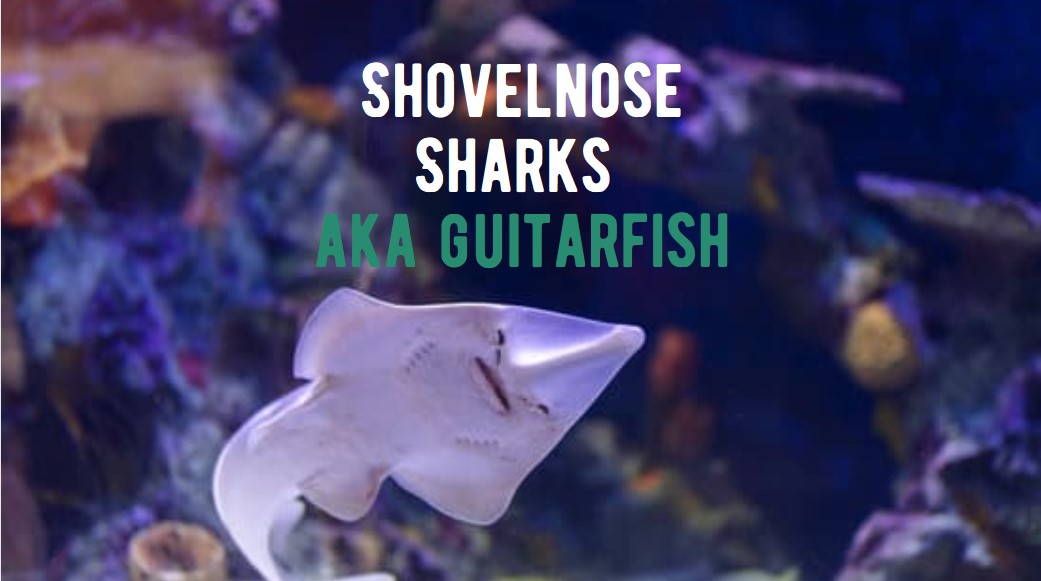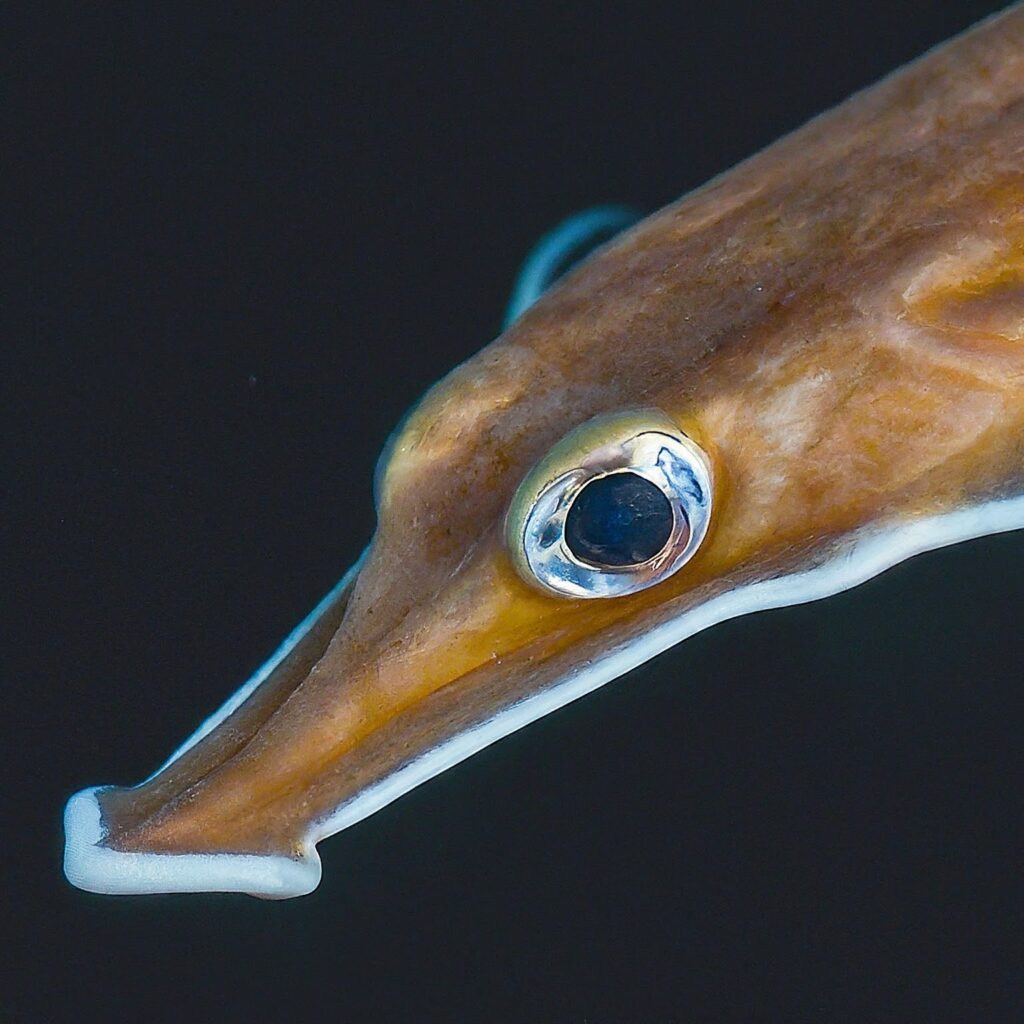
The shovelnose guitarfish (Pseudobatos productus) is a unique ray species found in the eastern Pacific Ocean, ranging from central California to the Gulf of California. With its distinctive “guitar-shaped” body and shovel-like snout, it has adapted perfectly for life on sandy seafloors.
Appearance Of Shovelnose Guitarfish:
- Flattened body: Similar to other rays, the shovelnose guitarfish has a flattened body, reaching up to 1.3 meters (4.3 feet) in length. This body shape allows it to glide gracefully through the water and burrow in the sand for camouflage.
- Shovel-like snout: Its most recognizable feature is its elongated, pointed snout, resembling a shovel. This adaptation helps it dig into the sand to bury itself while hunting or hiding from predators.
- Olive to sandy brown coloration: The upper body of the shovelnose guitarfish is colored olive to sandy brown, seamlessly blending in with the seafloor. Its underside is white for countershading, further aiding in camouflage.
- Small, rounded teeth: Its mouth is located on the underside of its head and equipped with small, rounded teeth ideal for crushing crabs, worms, clams, and small fishes, its primary food sources.
Geographical Distribution Of Shovelnose Guitarfish:
- Shovel-nose sharks are found in various habitats, inhabiting both shallow coastal waters and deeper offshore regions.
- Their geographical distribution spans various marine environments, including the Eastern Pacific, Western Atlantic, and the Indian Ocean.
- From the shores of Australia to the coastlines of North and South America, these guitarfish exhibit adaptability to diverse climates and conditions.
Habitat and Behavior Of Shovelnose Sharks:
- Sandy seafloor dweller: Prefers shallow coastal waters with sandy or muddy bottoms, including bays, seagrass beds, and estuaries.
- Diurnal burrower: Primarily active during the day, spending much of its time buried in the sand with only its eyes and spiracles exposed.
- Solitary hunter: Primarily a solitary creature, except during mating season. It utilizes its electroreception abilities to detect prey buried in the sand, then swiftly digs them out with its powerful pectoral fins.
- Live birth: The shovelnose guitarfish is ovoviviparous, meaning that the eggs develop inside the female’s body and hatch before birth. They typically give birth to 6-28 pups at a time.

Physical Appearance Of Shovelnose Sharks:
The distinctive appearance of the Shovel Nose Shark sets it apart from other marine species. With a body that resembles a hybrid between a shark and a ray, these guitarfish feature a flattened body and a distinctive, shovel-like snout.
Their pectoral fins are broad and wing-like, reminiscent of a ray, while the tail retains the characteristic shark fin structure. Their skin coloration can vary, providing effective camouflage in different seabed environments.
Food and Diet Of Shovelnose Guitarfish:
Shovel-nose sharks are opportunistic feeders with a diet that includes a variety of benthic invertebrates, small fish, and crustaceans. Their flattened snout is a specialized adaptation for hunting prey in the sandy or muddy seabed.
Using electroreceptors in their ampullae of Lorenzini, they can detect the electrical signals emitted by hidden prey, enabling them to locate and capture food efficiently.
Mode of Reproduction Of Shovelnose Sharks:
Like many elasmobranchs, shovel-nose sharks exhibit a reproductive strategy known as ovoviviparity. The females internally develop eggs that hatch inside the body and give birth to live pups. This mode of reproduction provides the young sharks with a better chance of survival as they are born in a more developed state. The gestation period and the number of pups per litter can vary among different species within the guitarfish family.
Conservational Status Of Shovelnose Sharks:
Understanding the conservational status of the shovel-nose shark is crucial for implementing effective measures to protect this species. While some guitarfish populations remain stable, others face threats due to habitat loss, overfishing, and unintentional capture in fishing gear.
- Near Threatened: Unfortunately, the shovelnose guitarfish is classified as “Near Threatened” by the IUCN due to several factors, including habitat loss, bycatch in fishing gear, and potential prey depletion.
Interesting Facts about Shovelnose Sharks:
- Camouflaging Colors: The skin coloration of shovel-nose sharks allows them to blend seamlessly with the sandy or muddy ocean floor, providing effective camouflage against potential predators.
- Mimicking Ray Behavior: Despite being sharks, the guitarfish often display behavior similar to rays, using their pectoral fins to “fly” over the ocean floor.
- Blunt Teeth and Harmlessness: Despite their relation to sharks, Shovelnose Guitarfish are relatively harmless to humans. Their blunt teeth, designed for crunching hard shells, rarely cause damage.
- Cross Between Shark and Ray: Shovelnose Guitarfish exemplifies the evolutionary link between sharks and rays with a shark-like tail and a ray-like head. Their swimming motion, moving the tail side-to-side, mirrors shark behavior.
- Ancient Lineage: Belonging to a primitive group of fish, the Shovelnose Guitarfish lineage has changed little over millions of years. Their genus includes around 15 species, displaying diverse sizes and habitat preferences.
- Rhine and Batis Origins: The Greek word “Rhine” for shark and the Latin word “Batis” for ray converge in the scientific name Rhinobatos, perfectly capturing the shark-ray essence.
- Ovoviviparous Reproduction: Female Shovelnose Guitarfish, like rays and sharks, are ovoviviparous, retaining fertilized eggs until they live young and are ready to hatch and be released.
- Masterful Disguise: Utilizing counter-shading, Shovelnose Guitarfish blends seamlessly with the sandy or muddy seabed, making them difficult to spot from above or below.
- Delicacy Status: Once considered by-catch, Shovelnose Guitarfish are now actively fished for their marketable and valuable meat. The tail meat is deemed mild-flavored, clean, and tasty.
- Electroreceptors and Sensory Adaptations: Shovelnose Guitarfish possess specialized sensors and electroreceptors on their snouts, enabling them to detect changes in water pressure and locate prey buried beneath the sand or mud.
- Unique Swimming Style: Unlike rays that glide through water using large fins, Shovelnose Guitarfish move their tails side-to-side, akin to sharks, showcasing a distinctive swimming style.
- Breathing Adaptations: Shovelnose Guitarfish can pump water through their gills to obtain oxygen, eliminating the need to keep swimming for respiration.
Frequently Asked Questions (FAQs):
Q1: Are shovel-nose sharks dangerous to humans?
A1: Shovel-nose sharks are generally considered harmless to humans. They have small teeth designed for crushing and grinding their prey, and interactions with humans are rare.
Q2: How do Shovel Nose Sharks reproduce?
A2: Shovel Nose Sharks reproduce through ovoviviparity, with females giving birth to live pups after the internal development of eggs.
Q3: What is the primary threat to the conservation status of shovelnose sharks?
A3: The primary threats include habitat loss, overfishing, and unintentional capture in fishing gear, which can impact the populations of shovel-nose sharks.
Q4: Where can Shovel Nose Sharks be found?
A4: Shovelnose Sharks have a widespread geographical distribution, inhabiting coastal waters in the Eastern Pacific, Western Atlantic, and the Indian Ocean.
Q5: How do Shovel Nose Sharks hunt for prey?
A5: Shovelnose sharks use their specialized, flattened snout and electroreceptors to detect prey hidden in sandy or muddy seabeds. They feed on benthic invertebrates, small fish, and crustaceans.
Summary
Exploring the world of shovel-nose sharks reveals a captivating story of adaptation, survival, and the intricate balance they maintain within the marine ecosystems they call home. From their unique physical features to their role in the delicate dance of ocean life, these guitarfish continue to be subjects of scientific study and conservation efforts to ensure their enduring presence in the vast expanses of the world’s oceans.
The shovelnose guitarfish is a fascinating creature that plays an important role in maintaining healthy marine ecosystems. Understanding and protecting this unique species is crucial for its survival and the overall health of our oceans.






